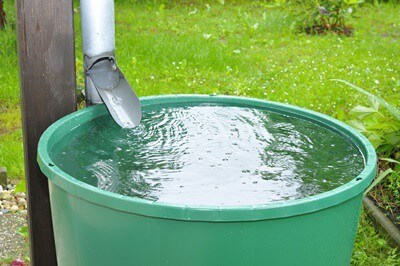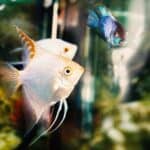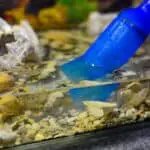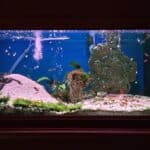Those that are new to owning fish will need to decide where to source water for their aquarium. Some choose to use tap water, while others use bottled. However, rainwater is also a popular option.
You can use rainwater to fill a fish tank, but it must be filtered before it’s entirely safe for use. That’s because, in polluted environments, rainwater absorbs pollutants and chemicals, carries diseases, and collects debris. It’s also low in minerals and slightly acidic. However, it doesn’t contain harmful chlorine or chloramine. Testing the water first will allow you to treat the water with the right chemicals or minerals to make it safe to use in your aquarium.
If you’re wondering whether you can put rainwater in your aquarium and want to know how to do it, we’ve got all the information you need to know to help you optimize your tank’s conditions.
Can I Use Rainwater In My Fish Tank?
While many owners use tap water to fill their tank, it’s not without its problems. That’s because it contains chlorine and chloramine, both of which are harmful to fish. When fish are exposed to these chemicals in high concentrations, they become poisoned by the chemicals and die.
Making tap water safe for fish takes time and effort, which is why rainwater is sometimes considered a more suitable option. It’s also free from chlorine and chloramine. However, like tap water, it’s not without its problems, which include:
Absorbs Pollution
Depending on where you live and how polluted your environment is, rainwater picks up airborne pollutants, including smoke, fumes, dust, and soot that’s dissolved into the rainwater.
As described by The International Water Association, when rainwater falls from the sky, land and air pollution melts into it.
Similarly, depending on how you collect your water, harmful chemicals from rainwater that’s come from unsanitary drainpipes, rooves, gutters, and other similar materials could be contaminated with lead, copper, and asbestos.
That’s why you must collect rainwater safely to ensure it’s free from chemicals and pollutants and safe for your fish. So, don’t collect rainwater within the first 30 minutes of a rainstorm. After this time, the water should wash the pollutants away, leaving the rest of the water safe to use.
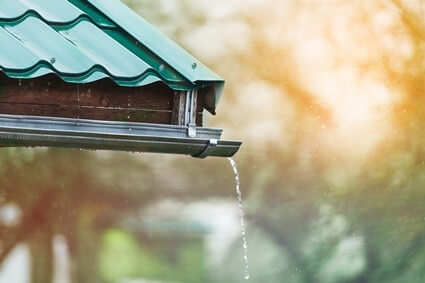
Carries Diseases
Rainwater can carry parasites, bacteria, and viruses that can make your fish sick if it’s collected from a dirty or contaminated environment.
However, this is rare if you use carefully-collected rainwater or remove pathogens from the rainwater with an effective disinfectant, as explained by NSW Health.
Collects Debris
Not only can rainwater collect dirt and pollutants, but it can become contaminated with small pieces of debris. Depending on what the rainwater’s collected, this debris can rot, releasing ammonia and tannic acid into the water. These chemicals are both harmful to fish.
This is most likely if you’re using a water butt or a similar piece of equipment to collect rainwater. As a result, rinse out your collection device as often as you can to remove debris particles that have gotten into your tank.
Low Mineral Content
Rainwater has virtually no hardness, which means it’s low in calcium, magnesium, potassium, sodium, and other minerals. The more dissolved minerals in the water, the harder the water is. As a result, rainwater is naturally soft.
This is beneficial for fish that live in soft water conditions, including discus fish and some cichlids. Adding Discus Buffer or Cichlid Lake Salt can help replicate your fish’s conditions by providing the right pH and acidity levels.
However, soft rainwater isn’t ideal for fish that need hard water. This includes guppies, mollies, swordtails, and African cichlids.
To combat this, most aquarists use rainwater alongside tap water that’s had the chlorine and chloramine removed to increase the hardness. This makes it suitable for a broader range of community fish.
Acidic
According to the United States Environmental Protection Agency, average rain has a pH of around 5.6. It’s slightly acidic because the atmosphere’s carbon dioxide forms weak carbonic acid by dissolving it into the water.
Again, this is fine for fish that prefer slightly acidic water with a lower pH. In fact, fish such as tetras and rasboras can survive in pure rainwater because of this acidity.
Like the mineral content, fish that prefer hard water can’t live in rainwater that’s not treated first. That’s why you need to test the rainwater before adding any fish into the tank.
What Are The Benefits Of Using Rainwater In A Fish Tank?
One of the most significant benefits of rainwater is that it doesn’t need to go through the dechlorination process before it’s used. That’s because it doesn’t contain chlorine or chloramine, which are both two of the biggest concerns associated with tap water.
You can also use rainwater to replace any water that’s evaporated out of the tank. Water levels naturally drop out of the tank, especially in aquariums that don’t have a lid. Heat is also another cause of water evaporation.
While this is normal, you’ll need to keep the water topped up. The great thing about rainwater is that you can add it to the tank without doing anything to it first, as small quantities shouldn’t upset the tank’s conditions.
You can also use it for your monthly or bi-weekly water changes when you replace some of the tank’s water. However, you’ll need to remineralize it first to ensure the water has all the nutrients your fish need to survive.
If you have hard-water fish and choose to start using rainwater, begin with 25% rainwater with your water changes, giving yourself time to see how your fish and tank react to the water. Then, measure the pH levels to ensure they remain between 6.5 and 7.5. If they do, increase the amount of rainwater you use to 50%.
As with any water change, keep measuring the conditions to ensure the ammonia and pH levels remain stable and that the tank contains all the nutrients it needs.
How To Collect Clean Rainwater for An Aquarium
While there’s a lot of debate around whether rainwater is safe for fish or not, the reality is that many tropical fish live in rainwater – or at least freshwater that gets rained on continuously. As a result, they’re naturally used to living in small quantities of rainwater.
Collecting rainwater for your fish tank is a relatively simple process, but you must do it carefully to avoid contamination.
The method of collecting your rainwater is arguably the most crucial step. So, make sure you’ve got the following things covered:
- Ensure the surface you collect your rainwater from isn’t metallic. It must be clean, and it mustn’t contain calcium either; otherwise, it could cause a calcium overload.
- Ensure all the pipe work’s made of plastic. Similarly, the collection vessel should be made with non-transparent plastic.
- Choose a vessel with a lid to prevent dirt and debris from getting in.
- Place your vessel away from direct sunlight if possible, as this is likely to cause bacteria to grow.
The best vessel is a large plastic water butt that has a secure lid. You can connect one to your drainage system, allowing the rainwater to collect from the roof or guttering in large quantities. This process also ensures you only collect rainwater, not groundwater, which is more likely to contain pollutants and bacteria.
Once you’ve collected your water, leave it to stand for a day or two, aiming for at least 24 hours. That’s because fresh rainwater is likely to have CO2, lowering the water’s pH levels. By aerating the water, the carbon dioxide will evaporate into the atmosphere.
Similarly, you can speed up the process by aerating the water with a pump or aquarium stone. This releases carbon dioxide by agitating the water’s surface, introducing higher quantities of oxygen. This will make the water safe for your fish.
How To Make Rainwater Safe For Your Aquarium?
Collecting rainwater isn’t quite as simple as leaving a vessel outside and putting the water into your aquarium once it’s full.
You need to do a bit of work beforehand to ensure the water’s safe and free from debris. Otherwise, the rainwater might contain some chemical traces that will make your fish sick. So, follow these steps to make your collected rainwater aquarium-safe.
Filter The Water
Before using rainwater in your tank, filter it first. Filtration can be as simple as a mesh covering or strainer placed across the inlet to your vessel. Clean this regularly to ensure the water’s as pure as possible.
For best results, use a stainless steel proprietary filter. While this device is more expensive, it’s also more effective and will last longer.
Filtering will stop leaves, bird feathers, and other large pieces of debris from getting into your water and tainting it. The finer the filter, the better it’ll work.
Oxygenate The Water
To stop your rainwater from going smelly, it’s a good idea to oxygenate it. However, you need to do so without disturbing the smaller pieces of debris that have settled at the bottom of your tank or collection vessel.
To do this, add a calmed inlet to the bottom of the vessel. This small, simple device ensures that rainwater going in jets upwards from the bottom. This oxygenates the water above the debris without disturbing it and tainting the water.
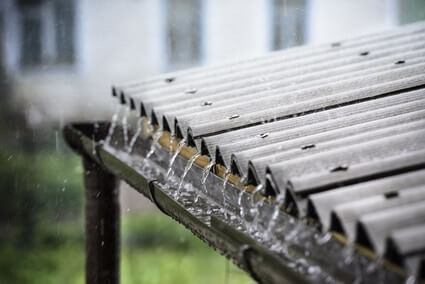
Siphon Off Particles
Some particles are too fine for your filter to collect, such as oils and pollen. They will float to the top of the water and sit on the surface.
Luckily, these particles are easy to skim off. An overflow siphon is the simplest way to do this, though you could also remove them manually. This ensures the water’s as clean and healthy as it can be for your fish.
Fit A Floating Intake Filter
You must ensure you only use the cleanest rainwater from your vessel for your fish tank. As described, some particles will settle on both the top and bottom of your tank. This means the cleanest water sits in the middle, which is what you need for your tank.
That’s where a floating intake filter comes in. It allows water to be collected 6” below the surface while straining debris, meaning only the cleanest water is harvested. This provides water that you can use in your fish tank straightaway.
Unfortunately, collecting rainwater for your fish tank isn’t as straightforward as you might first think. That’s because there are many unseen contaminants to consider. However, rainwater is a budget-friendly option when you can’t afford bottled water or the chemicals to treat tap water with.
Similarly, in rainy areas, rainwater is available in abundance. Not only that, but if you’re collecting rainwater for other reasons – to water your plants, for example – using rainwater can save time. Just remember to change the water in the tank in the right way.

